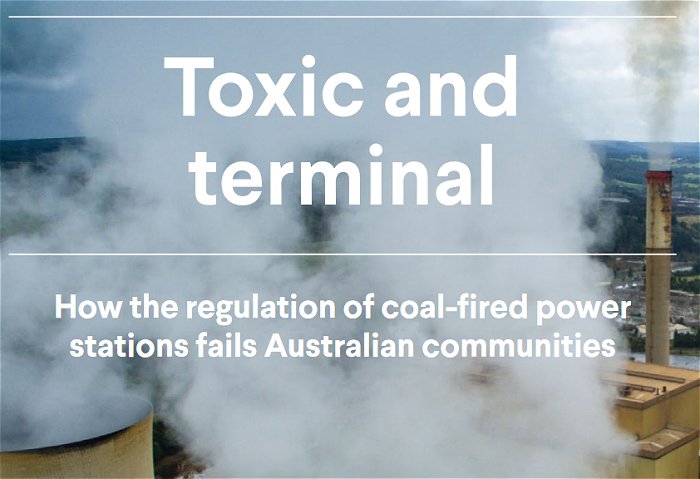
A new report says coal power regulations have failed Australians, and some of those that are in place are far less restrictive than in the US, EU – and even China.
Environmental Justice Australia’s (EJA’s) “Toxic and Terminal” report (PDF) reveals Australia has one of the oldest and most inefficient fleets of coal fired power stations in the world that are spewing a huge amount of toxic substances; with what appears to be the blessing of government.
Coal fired power generation pollution isn’t just about carbon dioxide. Burning coal emits dozens of toxic substances and is Australia’s biggest source of fine particulate pollution, sulfur dioxide (SO2) and oxides of nitrogen (NOx) says EJA. Added to this are the dangers posed by fly ash dams, some of which are located in or close to residential areas.
“People who live within 50 kilometres of coal-fired power stations are three to four times more likely to die prematurely than people who live further away,” said EJA lawyer and co-author Nicola Rivers.
The report states emissions limits applied to Australian power stations are significantly less strict than the standards in the European Union, United States and China. It cites an example of Loy Yang A power station in Victoria having a particle limit eight times China’s limit and claims mercury limits for some coal-fired power stations in New South Wales are up to 666 times higher than those in the USA.
Minimal Enforcement And Secrecy Surrounding Breaches
The report states it is “almost impossible” for the Australian public to determine if power stations are in compliance with pollution licences and laws. Furthermore, breaches of regulations seem to be fairly common and if punished, the action can be little more than a smack on the wrist.
When an ash pipeline associated with Yallourn Power Station ruptured in 2015, it spilled 8.6 million litres of ash slurry into the into the Morwell and Latrobe Rivers. The fine issued by the EPA was just $7,584.
Some power stations are serial offenders.
EJA says the 35-year old Eraring Power Station in New South Wales, which is Australia’s largest coal fired power generator, has breached its licence conditions on at least 23 occasions since 2006 – with one penalty notice issued. Incidents have included thousands of litres of oil entering Lake Macquarie and ash dams not being properly managed.
Stricter Standards And Phaseout Needed
Among its recommendations, EJA wants to see stricter emissions standards imposed that will give companies the incentive to install more effective pollution reduction controls that have been available for years. It points out that so-called HELE (high efficiency, low emission) plants aren’t the answer as they only marginally reduce toxic emissions (and really aren’t all that much better in relation to CO2).
Stricter standards, closer monitoring and increased transparency and accountability are only part of the solution. Coal power kills and given the myriad issues, any actions taken to clean it up will still amount to little more than a band-aid over a gangrenous wound.
“Ultimately though, the only way to avoid the death and disease that coal-fired power stations impose on Australian communities is to avoid the pollution in the first place,” states the report’s executive summary “This requires a transition away from coal-fired power stations to renewable energy generation, which produces no toxic pollution.”
EJA has called on Australian governments to rule out building, financing or approving any new coal fired power stations; instead committing to the development of renewable energy technologies to replace the nation’s electricity generation clunkers.
Environmental Justice Australia’s “Toxic and Terminal” report can be downloaded here (PDF).
In related news, a new study from the University of California, Berkeley says cumulative wind and solar power air-quality related benefits of 2015 in the USA was US $29.7–112.8 billion, mostly from 3,000 to 12,700 avoided premature deaths.

 RSS - Posts
RSS - Posts



Because that in the UK, diesel-fuelled vehicles are being banned on the basis of specified numbers of deaths caused by the use of the fuel, and, because the above article includes
“In related news, a new study from the University of California, Berkeley says cumulative wind and solar power air-quality related benefits of 2015 in the USA was US $29.7–112.8 billion, mostly from 3,000 to 12,700 avoided premature deaths.”
I am wondering whether credible estimates have been made, and published, of the number of premature deaths caused by both the generation of electricity by coal itself, and, by other “fossil fuels” as used in Australia, for electricity generation, and, especially, by the use of the coal that is mined in Australia, so leading to the questions including “How many people is the use of fossil fuels (for each fossil fuel used) in electricity generation in Australia, killing, each year?”, and, “How many people, both in Australia and overseas, are being killed, each year, by the use of coal mined in Australia?”.
And, if these numbers are not available, and, not published, then, the question needs to be asked;Why not?”.
I believe that this is an issue of the nature of the famous Erin Brokovich story.
And, I think it is reminiscent of Bhopal.